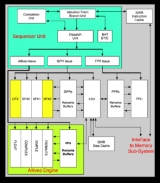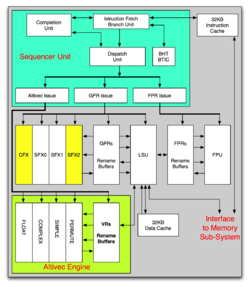
PowerPC e600
Encyclopedia
The PowerPC e600 is a family of 32-bit
Power Architecture
microprocessor
cores developed by Freescale for primary use in high performance system-on-a-chip
(SoC) designs with speed ranging over 2 GHz, thus making them ideal for high performance routing and telecommunications applications. The e600 is the continuation of the highly successful PowerPC G4
design, aka PowerPC 7400.
The e600 is a superscalar
out-of-order
RISC core with 32/32 kB L1 data/instruction caches
, a seven stage, three-issue pipeline
with load/store, system register, powerful branch prediction
, integer unit
, a double precision
FPU
and an enhanced 128-bit AltiVec
unit with limited out-of-order execution. The core is designed to work in multiprocessing
and multi core
designs and can take large amounts of L2 caches on die.
The e600 core is not compatible with the new Power ISA specification but adheres to the earlier PowerPC
specification and is completely backwards compatible with the PowerPC G4 cores from which it derives.
 In 2004 Freescale renamed the G4
In 2004 Freescale renamed the G4
core e600 and changed focus from general CPUs to high end embedded SoC devices, and introduced a new naming scheme, MPC86xx. The 7448 was to be the last pure G4 and it formed the base of the new e600 core.
, dual x8 PCI Express
and an on-die 667 MHz MPX interconnect between I/O, the cores, and dual 64-bit DDR2
-memory controllers (with ECC). The product also features four on-chip Gigabit ethernet
controllers with TCP
/UDP
offloading features. The dual core MPC8641D has support for asymmetric multiprocessing
, which enables two operating system
s to run on the same device simultaneously, sharing resources but largely unaware of each other.
The MPC8641 (single core) and MPC8641D (dual core) are manufactured on a 90 nm SOI based process. 8641 draws less than 16W at 1.33 GHz and 8641D less than 25W at 1.5 GHz.
Introduced in summer of 2008, the MPC8640 and MPC8640D are low power, low cost versions of the MPC8641 parts. Clocked at 1-1.25 GHz they draw 14-21W power while being identical to their older brethren in other respects.
supporting 24-bit screens sizes up to 1280x1024 pixels. It is a single core CPU with 256 kB on die L2 cache. Manufactured on a 90 nm process, it reaches speeds from 667 to 1333 MHz.
32-bit
The range of integer values that can be stored in 32 bits is 0 through 4,294,967,295. Hence, a processor with 32-bit memory addresses can directly access 4 GB of byte-addressable memory....
Power Architecture
Power Architecture
Power Architecture is a broad term to describe similar RISC instruction sets for microprocessors developed and manufactured by such companies as IBM, Freescale, AMCC, Tundra and P.A. Semi...
microprocessor
Microprocessor
A microprocessor incorporates the functions of a computer's central processing unit on a single integrated circuit, or at most a few integrated circuits. It is a multipurpose, programmable device that accepts digital data as input, processes it according to instructions stored in its memory, and...
cores developed by Freescale for primary use in high performance system-on-a-chip
System-on-a-chip
A system on a chip or system on chip is an integrated circuit that integrates all components of a computer or other electronic system into a single chip. It may contain digital, analog, mixed-signal, and often radio-frequency functions—all on a single chip substrate...
(SoC) designs with speed ranging over 2 GHz, thus making them ideal for high performance routing and telecommunications applications. The e600 is the continuation of the highly successful PowerPC G4
PowerPC G4
PowerPC G4 is a designation used by Apple Computer to describe a fourth generation of 32-bit PowerPC microprocessors. Apple has applied this name to various processor models from Freescale, a former part of Motorola....
design, aka PowerPC 7400.
The e600 is a superscalar
Superscalar
A superscalar CPU architecture implements a form of parallelism called instruction level parallelism within a single processor. It therefore allows faster CPU throughput than would otherwise be possible at a given clock rate...
out-of-order
Out-of-order execution
In computer engineering, out-of-order execution is a paradigm used in most high-performance microprocessors to make use of instruction cycles that would otherwise be wasted by a certain type of costly delay...
RISC core with 32/32 kB L1 data/instruction caches
CPU cache
A CPU cache is a cache used by the central processing unit of a computer to reduce the average time to access memory. The cache is a smaller, faster memory which stores copies of the data from the most frequently used main memory locations...
, a seven stage, three-issue pipeline
Instruction pipeline
An instruction pipeline is a technique used in the design of computers and other digital electronic devices to increase their instruction throughput ....
with load/store, system register, powerful branch prediction
Branch predictor
In computer architecture, a branch predictor is a digital circuit that tries to guess which way a branch will go before this is known for sure. The purpose of the branch predictor is to improve the flow in the instruction pipeline...
, integer unit
Arithmetic logic unit
In computing, an arithmetic logic unit is a digital circuit that performs arithmetic and logical operations.The ALU is a fundamental building block of the central processing unit of a computer, and even the simplest microprocessors contain one for purposes such as maintaining timers...
, a double precision
Double precision
In computing, double precision is a computer number format that occupies two adjacent storage locations in computer memory. A double-precision number, sometimes simply called a double, may be defined to be an integer, fixed point, or floating point .Modern computers with 32-bit storage locations...
FPU
Floating point unit
A floating-point unit is a part of a computer system specially designed to carry out operations on floating point numbers. Typical operations are addition, subtraction, multiplication, division, and square root...
and an enhanced 128-bit AltiVec
AltiVec
AltiVec is a floating point and integer SIMD instruction set designed and owned by Apple, IBM and Freescale Semiconductor, formerly the Semiconductor Products Sector of Motorola, , and implemented on versions of the PowerPC including Motorola's G4, IBM's G5 and POWER6 processors, and P.A. Semi's...
unit with limited out-of-order execution. The core is designed to work in multiprocessing
Multiprocessing
Multiprocessing is the use of two or more central processing units within a single computer system. The term also refers to the ability of a system to support more than one processor and/or the ability to allocate tasks between them...
and multi core
Multi-core (computing)
A multi-core processor is a single computing component with two or more independent actual processors , which are the units that read and execute program instructions...
designs and can take large amounts of L2 caches on die.
The e600 core is not compatible with the new Power ISA specification but adheres to the earlier PowerPC
PowerPC
PowerPC is a RISC architecture created by the 1991 Apple–IBM–Motorola alliance, known as AIM...
specification and is completely backwards compatible with the PowerPC G4 cores from which it derives.
CPUs

PowerPC G4
PowerPC G4 is a designation used by Apple Computer to describe a fourth generation of 32-bit PowerPC microprocessors. Apple has applied this name to various processor models from Freescale, a former part of Motorola....
core e600 and changed focus from general CPUs to high end embedded SoC devices, and introduced a new naming scheme, MPC86xx. The 7448 was to be the last pure G4 and it formed the base of the new e600 core.
MPC7448
The 7448 is an evolution of the 7447A and is essentially a faster (up to 2 GHz) and more power-efficient version of the 7447A manufactured in 90 nm with 1 MB L2 cache and up to 200 MHz front side bus and it features Freescale's new standard core, the e600.MPC864x
The problems associated with the bandwidth-constrained external MPX bus interface found on the 74xx series are relieved with single (MPC8641) or dual (MPC8641D) e600 cores, faster system interface via RapidIORapidIO
The RapidIO architecture is a high-performance packet-switched, interconnect technology for interconnecting chips on a circuit board, and also circuit boards to each other using a backplane...
, dual x8 PCI Express
PCI Express
PCI Express , officially abbreviated as PCIe, is a computer expansion card standard designed to replace the older PCI, PCI-X, and AGP bus standards...
and an on-die 667 MHz MPX interconnect between I/O, the cores, and dual 64-bit DDR2
DDR2 SDRAM
DDR2 SDRAM is a double data rate synchronous dynamic random-access memory interface. It supersedes the original DDR SDRAM specification and has itself been superseded by DDR3 SDRAM...
-memory controllers (with ECC). The product also features four on-chip Gigabit ethernet
Gigabit Ethernet
Gigabit Ethernet is a term describing various technologies for transmitting Ethernet frames at a rate of a gigabit per second , as defined by the IEEE 802.3-2008 standard. It came into use beginning in 1999, gradually supplanting Fast Ethernet in wired local networks where it performed...
controllers with TCP
Transmission Control Protocol
The Transmission Control Protocol is one of the core protocols of the Internet Protocol Suite. TCP is one of the two original components of the suite, complementing the Internet Protocol , and therefore the entire suite is commonly referred to as TCP/IP...
/UDP
User Datagram Protocol
The User Datagram Protocol is one of the core members of the Internet Protocol Suite, the set of network protocols used for the Internet. With UDP, computer applications can send messages, in this case referred to as datagrams, to other hosts on an Internet Protocol network without requiring...
offloading features. The dual core MPC8641D has support for asymmetric multiprocessing
Asymmetric multiprocessing
Asymmetric multiprocessing, or AMP, was a software stopgap for handling multiple CPUs before symmetric multiprocessing, or SMP, was available.Multiprocessing is the use of more than one CPU in a computer system...
, which enables two operating system
Operating system
An operating system is a set of programs that manage computer hardware resources and provide common services for application software. The operating system is the most important type of system software in a computer system...
s to run on the same device simultaneously, sharing resources but largely unaware of each other.
The MPC8641 (single core) and MPC8641D (dual core) are manufactured on a 90 nm SOI based process. 8641 draws less than 16W at 1.33 GHz and 8641D less than 25W at 1.5 GHz.
Introduced in summer of 2008, the MPC8640 and MPC8640D are low power, low cost versions of the MPC8641 parts. Clocked at 1-1.25 GHz they draw 14-21W power while being identical to their older brethren in other respects.
MPC8610
Introduced in 2007 the MPC8610 is a host processor with integrated graphics processorGraphics processing unit
A graphics processing unit or GPU is a specialized circuit designed to rapidly manipulate and alter memory in such a way so as to accelerate the building of images in a frame buffer intended for output to a display...
supporting 24-bit screens sizes up to 1280x1024 pixels. It is a single core CPU with 256 kB on die L2 cache. Manufactured on a 90 nm process, it reaches speeds from 667 to 1333 MHz.

